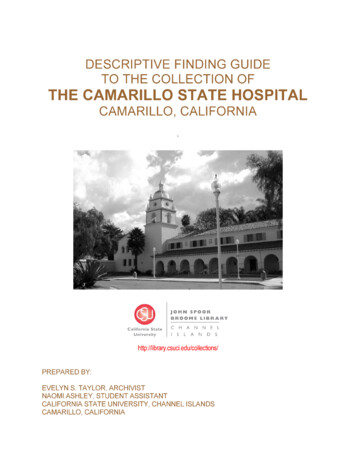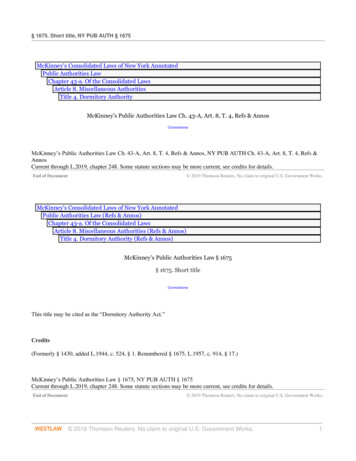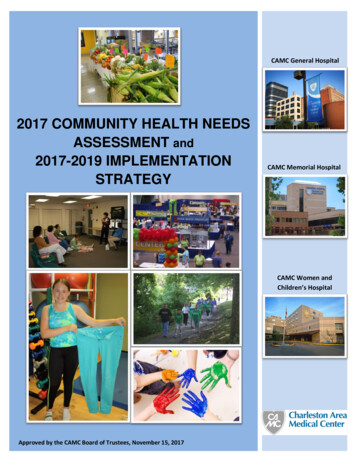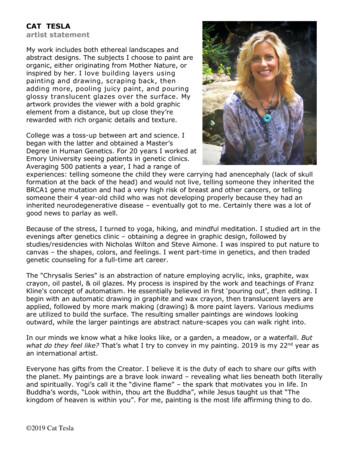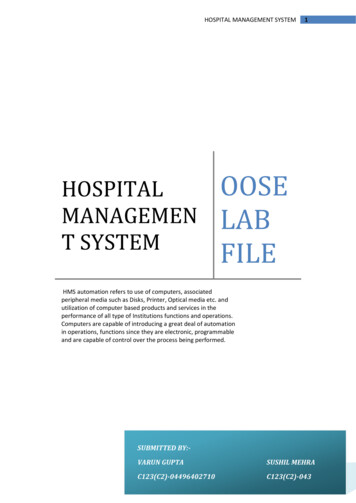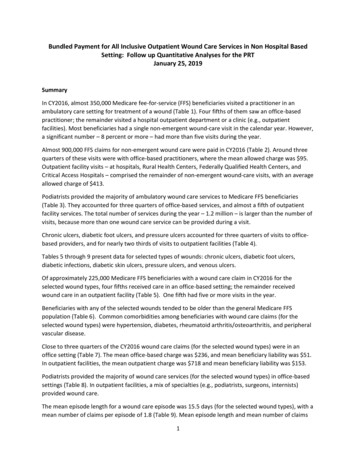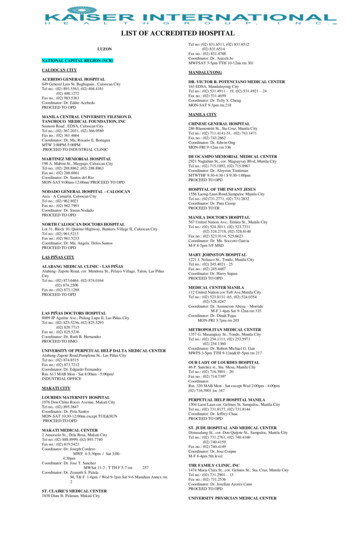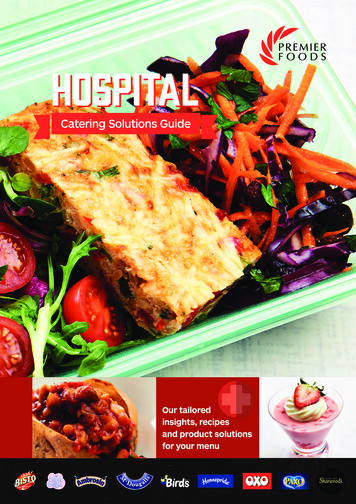
Transcription
HOSPITALCatering Solutions GuideOur tailoredinsights, recipesand product solutionsfor your menu
Find our deliciousBisto Lentil Souprecipe on page 21ContentsIntroduction3Testimonials4Raising the bar in hospital catering5CQUIN Guidance6Spotlight on: Food Packaging& Food for Life7Product guide8Allergens10Top tips for caterers12Big issues & recipe solutions: Patient14Big issues & recipe solutions: Staff18Big issues & recipe solutions: Visitor22Social media26Sustainability272Hospitals Catering Solutions Guide
From our kitchen to yoursWelcome to the Premier Foods Hospital Solutions Guide, which has been createdto equip you with recipe ideas and practical tips to help you create nutritious mealsfor your patients, staff and visitors. We are proud to be continuing our investmentin industry-leading research that allows us to provide you with menu solutions thatenable you to be at the forefront of your customers’ needs.We understand the important role that mealtimes play in hospitals. There is a real need for brands and menusolutions you can rely on with the day-to-day challenges of: managing budgets, meeting the requirements ofa varying range of dietary needs and providing a delicious menu that is compliant and ensures the well-beingof patients and staff.Within this guide, you will find a number of recipe solutions for your patients, staff and visitors, all of whichare underpinned by the results of research undertaken by YouGov, on behalf of Premier Foods.The recipes are cost-effective, using ingredients and equipment that can be found in the average hospital kitchen,making it as easy as possible to meet the needs of your customers. You will also find advice on some of the keyissues hospital caterers face, as well as top tips to help you comply with the Food Information Regulations (FIR).The research was conducted on behalf of Premier Foods by YouGov in February 2017. This guide is basedon the results of three online surveys among the following samples:nn1,062 UK adults aged 16 who have eaten in an NHS hospital as a patient or visitor in the last five yearsnn509 UK adults aged 16 who have eaten in a private hospital as a patient or visitor in the last five yearsnn254 UK adults aged 16 who currently work in a hospital or have done so within the last five yearsHospitals Catering Solutions Guide3
TestimonialsImproving meal standards in hospitals for patients, staff and visitorscontinues to be a key focus for Premier Foods and we’re dedicated toputting the needs of caterers at the heart of what we do.We have been proud supplier members of the Hospital Caterers Association (HCA) since 2013.The HCA is focused on promoting, developing and improving the standards of catering in healthcare.As one of the first professional associations to be formed within the NHS, it represents over 400 seniorhealth care catering managers and dieticians who provide a wide range of food services for patients,visitors and staff in NHS hospitals and healthcare facilities nationwide.Phillip Shelley“The expertise that Premier Foods brings to thehospital catering industry is invaluable with theknowledge that our healthcare caterers are reachingout for advice and recipes from a supplier that trulybring freshness to food choices. The supportivenature of the Premier Foods team reflects the typeof working relationship that is exemplar for cateringcolleagues and I am sure that the collaborativepartnership will grow from strength to strength.”Honorary National Chair, HCA“Healthcare caterers have a fundamental role to playwithin patient care plans. It’s a very complex role withmany differing patient groups, in addition to consideringstaff and visitor catering, all of which has the commontheme of eating for good health.Andy Jones,Past Chair, HCA4Hospital ideThe Premier Foods Hospital Solutions Guide is aninvaluable resource that provides the industry withinformation, support and advice on what products canassist us in ensuring that we meet the needs of ourpatients, staff and visitors. It offers ideas and inspiration,and Premier Foods is not only to be congratulated onits collaborative approach, but also for its continuedinnovation and focus on ensuring that we have thetools to deliver the best catering service.”
Raising the bar in hospital cateringThere is no doubt that food plays an important role in a hospital environment.For patients, it provides a source of nutrition to help aid recovery and providesa moment of social interaction that is important for their overall well-being. Foodis a source of fuel to keep staff energised throughout their shift. A compelling foodoffer also provides an opportunity to drive sales from a captive audience of visitors,including patients’ family members, so it is important to ensure your offering is rightfor your audience. We’ve therefore commissioned new research with YouGovto understand the opinions and attitudes of consumers who have recentlyexperienced hospital food as patients, visitors or staff.The research found that overall, people’s opinion ofhospital food is improving. Almost half of patients, visitorsand employees have positive views of the food available,and nearly half of respondents (49%) think it is generallymuch better than it was.Those who have eaten either as a patient or visitor inan NHS hospital in the past five years say food choiceis improving too – more than two thirds of respondentsagreed or strongly agreed that there was a good choiceof food available (41%) up by 9% compared to similarresearch carried out in 2015.That being said, the research revealed some keyimprovement areas. Although the food itself is seenin a positive light overall, ensuring patients, visitors andstaff are provided with choices that are tasty, appetising,satisfying and suitable for patients’ needs should be thekey areas of focus for caterers.“The quality of food provided in hospitalsis important to patients and hospitals shouldcater for your personal dietary needs.”Hospital Food Standard NHS Hospital ServicesHospitalsHospital Catering Solutions Guide5
The Commissioning for Qualityand Innovation (CQUIN) GuidanceThe NHS is actively taking steps to serve more healthy and nutritious options for hospital staff,visitors and patients with the introduction of new Health and Well-being (CQUIN) Guidance 2016/17.There are three parts to the national CQUIN Guidance which include:nn1a. Introduction of health and well-being initiativesnn1b. Healthy food for NHS staff, patients and visitorsnn1c. Improving the uptake of flu vaccinations for frontline staffWhen it comes to CQUIN 1b (ensuring healthy food provision for NHS staff, patients and visitors), the guidanceis split into two parts with the following requirements for all catering services on the hospital premises, includingretail outlets, vending machines, restaurant and patient catering offer:Part A of 1b:Part B of 1b:Providers are expected to implement the followingchanges within their catering outlet:nnSection A: Banning of price promotions on sugarydrinks and foods high in fat, sugar and salt (HFSS)such as breakfast cereals and confectioneryEvidence of the changes highlighted in Part A of 1b willneed to have been provided by 31st March 2017, withfunding awarded against this according to completionand compliance demonstrated.nnSection B: Banning of advertising on NHS premisesof sugary drinks and HFSS foodsPlease contact your procurement team for detailsof funding within your trust.nnSection C: Banning of sugary drinks and HFSS foodsat the checkoutnnSection D: Ensuring the availability of healthyoptions throughout the day, including those staffworking night shifts2016/17:Helpful hints to remain compliant with CQUIN;;foods and replace these with healthierRemove price promotions that include HFSSinstead of crisps and chocolate in mealoptions. For example offer crudités and fruitideasdeals. See our recipes on pages 12 – 17 for moremerchandise highlighting HFSSRemove any point of sale, posters or brandedal materials to drive awarenessproducts. Instead use your POS and promotionlow in fat, salt and sugarof your catering outlet and highlight productscheckout and away from thePlace any HFSS food and drinks away from theplacing them at the bottomimmediate eye line of consumers, for examplelow in fat, salt and sugar areof vending machines and ensuring productsmore prominentfeature prominently in your vendingEnsuring products low in fat, salt and sugarensure you are complying with sectionoffer, and keeping this fully stocked, will alsotimes – particularly if you do not offerD, ensuring healthy options are available at alla 24-hour restaurant;;;;;;customers with our recipe solutionsWe are proud to provide support to our hospitalremain compliant, but are underpinnedand top tips which not only aim to help caterersby our research findings.6Hospital Catering Solutions Guide
gSpotlight on: food packaginfied as a major barrier toFood packaging has been identis and the healthcare industrynutrition, particularly in hospitalpatients often need helpamongst elderly patients. Theses, sandwich packs or sauceto open items in plastic food tube facilities have identifiedsachets. Many hospitals and cary to help improve patients’the ISO 17480 standard as a way and inclusion, whilstnutrition, independence, dignites as efficient as possible.simultaneously making meal timaccount theaccreditation which takes intoISO 17480 is a packaging designproductsabilities of individuals to ensurevarying physical and sensory capbilities and elderly people.can be used by people with disaproduct rangesmost popular single-portionedWe have therefore put one of ourISO 17480Custard Pots) through the rigorous(Ambrosia Rice Pots & Ambrosiameets the ISOto ensure the packaging formattesting process. This is not onlyy come fromthe barrier to nutrition that maguidelines but, vitally, to reducepre-packaged products.products bys to improve the ease of openingThe ISO 17480 accreditation lookare pleaseddesign of product packaging. Weoutlining specific criteria for thegnition acrossflying colours to achieve this recothat the products passed withs the averagepackaging is tested for includethe range. The criteria that theber of failuresseconds in this instance), the numopening time (which was 3.26brosia potsAmsatisfaction score, of which theto open (none) and the averageachieved 4.53/5.rative work withlts and will continue our collaboWe are delighted with the resuolder peoplerove packaging accessibility forthe industry to identify and impand those with disabilities.Over 40,000 Food for LifeServed Here accreditedmeals are served daily topatients, staff and visitorsin UK hospitals – that’s 13.5million meals a year.Food for LifeServed Here‘Food for Life Served Here’, previously known as the Soil Association’s Food forLife Catering Mark, is a widely respected scheme recognised by the Departmentof Health, Department for Education, and the Government’s Plan for PublicProcurement. The scheme is raising the standards of food quality, provenance,and environmental sustainability in public and private sector catering.We’re proud to have joined the prestigious Food for Life Supplier Scheme whichmeans we have a range of products available that meet Bronze level standards.Hospital caterers can purchase some of the UK’s biggest brand names, includingMcDougalls, Paxo and Ambrosia, with the reassurance that they meet thescheme’s entry level criteria. We can also provide advice to help caterersgain additional points to achieve Silver and Gold awards.Hospital Catering Solutions Guide7
Our top 15recommendedPremier Foodsproducts forhospitalsAmbrosiais the leadingambient dessertsbrand**IRI, 12 w/e value data 16.01.16.McDougallsDelivering trustedsolutions for over150 years!
Bistois the consumersNo.1 gravy brand**IRI Grocery Outlets, 52 w/e 13th August 2016.
AllergensGoing into hospital can be a stressful experience, even more so if you have a food allergy,coeliac disease, food intolerances or special dietary requirements. It is vital that hospitalsare able to cater for individuals with allergies and intolerances, and are adhering to theFood Information Regulations which came into force in December 2014. These regulationsintroduced a requirement that food providers must highlight information about theallergenic ingredients used in any food they sell or provide.Sulphur dioxide(sometimes known as sulphites)Dried fruit such as raisins, driedapricots and prunes. Also meatproducts, soft drinks, vegetablesas well as wine and beer.LupinLupin flour andseeds can be usedin some types ofbread, pastries andeven in pasta.FishFish sauces, pizzas,relishes, salad dressings,stock cubes andWorcestershire sauce.EggsCakes, some meat products,mayonnaise, mousses, pasta,quiche, sauces and pastriesor foods brushed or glazedwith egg.NutsBreads, biscuits, crackers,desserts, nut powders (often usedin Asian curries), stir-fried dishes,ice cream, marzipan (almondpaste), nut oils and sauces.SoyaBean curd, edamamebeans, miso paste,textured soya protein,soya flour or tofu. Also,desserts, ice cream,meat products, saucesand vegetarian products.10Hospital Catering Solutions GuideMustardLiquid mustard, mustardpowder and mustardseeds. Also breads,curries, marinades, meatproducts, salad dressings,sauces and soups.
There are 14 major allergens which need to be mentioned (either on a label or throughprovided information such as menus) when they are used as ingredients in a food.Here are the allergens, and some examples of where they can be found:PeanutsBiscuits, cakes, curries,desserts, sauces (such assatay sauce), groundnutoil and peanut flour.MolluscsMussels, land snails, squidand whelks. Also in oystersauce or as an ingredientin fish stews.CrustaceansCrabs, lobster, prawnsand scampi. Shrimp paste,often used in Thai andsouth-east Asian curries orsalads, is an ingredient tolook out for.MilkButter, cheese, cream, milkpowders and yoghurt. Foodsbrushed or glazed withmilk, and powdered soupsand sauces.Cereals containing glutenCeleryCelery stalks,leaves, seedsand celeriac.Also, celery salt,salads, some meatproducts, soupsand stock cubes.Wheat (such as spelt and Khorasanwheat/Kamut), rye, barley and oatsis often found in some types ofbaking powder, batter, breadcrumbs,bread, cakes, couscous, meatproducts, pasta, pastry, sauces,soups and fried foods whichare dusted with flour.Sesame seedsBread (sprinkled on hamburgerbuns for example), breadsticks,houmous, sesame oil and tahini,toasted and used in salads.Hospital Catering Solutions Guide11
Top Tips for caterers:Patient cateringCommunicationnn If the patient has a pre-arranged stay, theymay wish to contact the catering manager tounderstand what can be provided to meet theirneeds. Caterers should therefore keep productand recipe information to hand and should beprepared to share allergy information from theirmenu to give reassurance to patients that theywill be catered fornn Have an internal and external allergy policyand where appropriate, post information onyour website to reassure patients and visitorsthat their needs will be catered fornn Ensure all staff on the ward are aware offoods that patients can and cannot eatnn Provide information that is readily availableon what you can and can’t provide, as wellas the procedures you have in place to avoidcontaminationnn A patient may not be well enough to reador understand the menu including allergens.Staff should speak to a friend or familymember to ensure patient requirements arecommunicated to the catering manager on dutynn Some procedures will state that patients willnot be discharged until they have eaten a biscuitand had a cup of tea. Ensure alternatives suchas fruit are available for individuals that maysuffer from a food allergy or intolerance toensure sufficient nutrition and hydrationbefore they are dischargedStaff and Visitor Cateringnn Ensure adequate provisions are available to fuelstaff and visitors throughout the day either inthe restaurant or vending machines for thosewith a special dietary requirements, so theyare able to make a purchase if not suppliednn For hospitals that are unable to provide roundthe clock catering, an adequate and satisfyingvending offer with ‘free from’ options will becrucial for staff members that work outsideof the canteen’s opening hoursnn Have an allergy expert, trained to level 2, on dutyat all times who can give accurate information ensure all staff know who this is and understandto direct queries to this personnn Remember there are 14 allergens listed in theFIR, but there are over 250 allergens which canaffect someone, if you are asked to provide asafe meal containing an allergen NOT listed,listen and communicate accurately what youare able to provideStaff Trainingnn Ensure all those that handle food have had BasicAllergen Training. Nurses and auxiliary staff onwards should also have basic online training orattend a seminar to understand all implicationsof allergens, coeliac disease and intolerancesnn Have a written procedure for how allergy queriesshould be dealt withnn Ensure all catering and ward staff are awareof any recipe changesnn Ensure staff are aware of which patients have anallergy or intolerance, for example by ensuring all‘free from’ meals are labelled with the patient’sname and bed numberspiTpTo12Hospital Catering Solutions Guide
Purchase and Delivery of ProductsHandling and Preparationnn Check the products ordered are theproducts deliverednn Make sure that your kitchen staff usethe same recipes every timenn Have an agreement in place to ensure that yoursuppliers notify you with any recipe changesnn When you are making a dish, keep a recordof all the ingredients (and what they contain),including cooking oils, dressings, toppings,sauces and garnishesnn Check nothing has been damaged as this couldcause cross contaminationStorage of Productsnn Make sure you have allergen informationfor all your products in storagenn Ensure all products are stored securelyto ensure no cross contaminationnn Store allergens on lower levelsto avoid spillagesnn Where appropriate, build in a preparationarea for allergen free items to minimise crosscontamination. Alternatively, have a safedocumented procedure of what needs tobe done to ensure safe preparation/cooking,for example some foods should be cookedin a dedicated fryernn Ensure food handlers wash hands in betweenpreparation of dishes, and gloves are availablewhere many foods are preparednn Use dedicated utensils and trays for allergen-freedishes, for example – all wards should aimto have a separate toaster for gluten free breador be able to provide toaster bags to avoidcross contaminationFor training, auditing and consultancy support to create yourallergy policy in regard to all allergens visit www.FATC.co.ukYou can find more allergen information and resources atwww.food.gov.uk/allergen-resourcesHospital Catering Solutions Guide13
Big issues & recipe solutions: PatientAt Premier Foods, we understand that patient catering is a complex task. Many differentpreferences and lifestyle choices need to be catered for, with patients ranging from youngchildren to the elderly, from minor injuries to major illnesses, all with varying cultural backgroundsand nutritional requirements. We’ve therefore developed a number of menu solutions withinthis guide, all of which can be adapted to cater for your patients’ specific needs.One third of patientswant to see more snacksand light food optionsavailable outside of mealtimesSet Fruited YoghurtsNumber ofservings: 10Prep time:10 minutesCook time:N/AProduct:McDougalls StrawberryJelly CrystalsAllergens: MilkCombining yoghurt and jelly adds flavour and texture,offering a simple yet indulgent solution that can stretchacross patient, staff and visitor dining.The research showed patients want to see more snacks and light food options available outside of meal times,so this recipe would work well as a satisfying snack or light dessert option.IngredientsMethod 200g McDougallsStrawberry Jelly Crystals 400ml Boiling water 400g Low fat natural yoghurt1. Dissolve the McDougalls Jelly Crystals in the boiling waterand allow to cool slightly2. Mix through the yoghurt and pour into 10 suitable moulds(100g each), place in the fridge until set, then serveHints & Tips:For a more indulgent recipe, for both staff and visitors, simply replace low fat yoghurt with Greek style yoghurt and add freshly choppedstrawberries into a serving dish, before pouring over the mix. This recipe also works well with McDougalls Lime and Orange Jellies.14Hospital ide
Although more than half of respondents that have eaten food as a patient in hospital agree orstrongly agree that food provided for patients is very good (56%), 58% of NHS hospital patientsand visitors felt that hospital food should be more suitable for patients’ needs. Whilst patientrequirements will need to be discussed on a case by case basis, we’ve developed a numberof recipes to help ensure adequate nutrition to aid recovery.The researchrevealed patientswanted to see more freshfood on the menuSpiced Orange CakeNumber ofservings: 10Prep time:10 minutesCook time:80 minutesProduct:McDougalls CarrotCake MixAllergens: Egg, Milk, Wheat, Soya.McDougalls cake mixes can be baked at a lowertemperature, which gives an opportunity to bringthe smell of 'freshly baked' cake to the ward.Cooking cakes at low temperatures in regeneration trollies has been proven to work well in a hospitalenvironment – a convenient way for caterers to provide freshly baked goods on the ward.IngredientsMethod 1kg McDougalls CarrotCake Mix 100g Vegetable oil 450ml Orange juice1. Place the McDougalls Carrot Cake Mix into a mixing bowl fitted with a beater2. Blend in the orange juice and oil on slow speed for 1 minute, then scrape downand continue mixing for 4 minutes on a medium speed3. Place the batter in a lined or non-stick, half size gastronorm tray and bake ina ‘regeneration trolley’ at 120 C for approx. 80 minutes, or until fully baked4. Cool slightly and cut into portions (75g)Hints & Tips:Try adding dried fruits, such as cranberries or sultanas into the mix. You can also bake the cakes (at 175 C)in muffin cases (90g) for both staff and visitors.HospitalsHospital Catering Solutions Guide15
Crustless Bacon Quiche pictured,see below for vegetarian optionCrustless QuicheNumber ofservings: 10Prep time:10 minutesCook time:30 minutesProduct:Paxo Sage& Onion StuffingAllergens: Eggs, Milk, Wheat, Barley, CeleryThis recipe works really well in a hospital environment.Not only does 'finger food' work well as a snack forpatients who may be in recovery, or elderly patientslooking for small portions that are easy to eat, but itprovides caterers with a practical solution that is easyto make, quick to bake and easy to serve.As it is crustless, it will reduce time as the pastry does not need to be blind-baked beforehand. It can be servedhot or cold and is extremely versatile, lending itself to a number of flavour and texture combinations to add varietyto your menu.IngredientsMethod 1. Pre-heat the oven to 170 C 20ml Vegetable oil2 Red peppers, sliced300g Onion, chopped100g Broccoli250g Canned choppedtomatoes, drained75g Paxo Sage& Onion Stuffing10 Eggs, beaten200g Mature cheddarSeason to taste2. Fry the peppers and onions in the oil until tender. Blanch the broccoli, drain and refresh3. Mix the drained tomatoes and stuffing together, add the vegetables and the eggsand half the cheese and combine4. Place in a lined or non-stick half gastronorm tray, top with the rest of the cheeseand bake for 25-30 minutes5. Cut into cubes or slices, depending on the client needs or service areaHints & Tips:This is a vegetarian recipe but why not try swapping the peppers and broccoli for 300g chopped lean smoked bacon,as pictured on this page.16Hospital ide
Roast dinners areone of the most popularoptions in hospitalsRoast Beef DinnerNumber ofservings: 10Prep time:30 minutesCook time:2 hoursProduct:Bisto Gluten Free Gravy Granules& McDougalls Premium Yorkshire Batter MixAllergens: Only with Yorkshire Pudding: Milk, Eggs, Wheat, SoyaRoast Dinner is one of the most popular optionsand already occurs twice a week in many hospitals.The familiar tastes of Bisto Gravy and Paxo stuffing which are synonymous with roasts provides patients withthe comforting taste of home – our Bisto Gluten Free Gravy provides a solution for those with a gluten intolerance,but be sure to remove other gluten based items from the dish (such as Yorkshire Puddings) and avoid crosscontamination. For more tips on allergens, see page 10.IngredientsMethod 1. Preheat the oven to 200 C1.2kg Beef silverside (tied)Salt & pepper to season750g Mashed potato400g Carrots400g Broccoli60g Bisto Gluten FreeGravy Granules 750ml Water 750g McDougalls PremiumYorkshire Batter Mix(optional: not gluten free)2. Place the beef in a deep-sided roasting tray and season3. Roast the beef for 20 minutes and reduce the oven temp to 170 C, then continue roasting for20 minutes per 500g, reaching a core temperature of a minimum 56 C (add a little wateror stock back to the tray, to stop it drying out)4. Remove the beef from the roasting tray and place to one side to rest, keep the meat juicesfor the gravy5. Place the roasting tray on top of the stove and deglaze with the water6. Whisk in the Bisto Gluten Free Gravy Granules and then pass through a sieve into a clean pan7. Serve 2 slices of beef (100g) with a scoop of mashed potato (75g), carrots and broccoli(40g each) & Bisto Gluten Free Gravy (Yorkshire pudding optional)Notes:If you prefer the meat more well done, it’s best to cook it at a lower temperature with a little stock in the base. Follow the sameinstructions, to initially roast the meat for 20 minutes and then turn the oven down to 140 C and cook for 4-6 hours (dependingon the size of the joint) until tender.HospitalsHospital Catering Solutions Guide17
Big issues & recipe solutions: StaffMaintaining the health of the workforce and encouraging a healthy diet is a major priority forthe NHS. Our research revealed that nearly half of staff members surveyed say they make surethey eat healthily (46%). Reducing sugar intake is a high priority, with 41% regularly checkingsugar levels in products before purchasing. In addition, only 17% of staff agreed or stronglyagreed that they felt satisfied after eating a hospital meal, therefore filling meals and healthysnacking options to fuel them throughout the day will be essential to your menu.Fruit & Seed Flapjack BarNumber ofservings: 10Prep time:10 minutesCook time:30 minutesProduct:McDougalls Flapjack MixAllergens: Sulphites, Egg, Milk, Wheat, Oats, SoyaWith over 50% oats, McDougalls Flapjack Mix is a greatbase for building flavours and textures to provide a satisfyingoption on your menu that is easy to eat on the go.You can add a variety of ingredients, such as fruits or nuts and control portion sizes to deliver specificnutritional value, or meet a price point.IngredientsMethod 500g McDougallsFlapjack Mix 50ml Water 15g Pumpkin seeds 15g Sunflower seeds 15g Sesame seeds 50g Chopped dates 50g Dried cranberries 50g Currants 5g Mixed spice1. Place the McDougalls Flapjack Mix and all the fruits, spices and seeds into a mixingbowl fitted with a beater2. Blend in the water on slow speed and mix for 15 seconds until mix is moist3. Press into a suitable greased and lined baking tin so the mix is approx 3cm deep4. Bake in a pre-heated oven at 170 C for 25-30 minutes, or until golden brown5. Cool and cut into portions (75g)Hints & Tips:If it’s suitable, you can add a variety of nuts back to the mix or why not try adding cocoa powder with a little bit of mixed spice.18Hospital ide
We’ve therefore focused on developed solutions that are either reduced-sugar oruse natural sugars from fruit. Our McDougalls Flapjack recipe is sweetened using dates,incorporates a number of spices to add flavour and contains pumpkin, sesame andsunflower seeds as a source of added nutrition.Bird’s Mousse/Ice Cream RecipeNumber ofservings: 10Prep time:20 minutesCook time:N/AProduct:Bird's Ice CreamPowder MixAllergens: MilkOur Bird’s Ice Cream Mix is extremely versatile. It can beprepared as a mousse or traditional frozen ice cream, combinedwith fruit as a source of natural sweetness, and providesa source of calcium if prepared with milk.IngredientsMethodStage 1 100g Bird's Ice CreamPowder Mix 200ml Semi skimmed milk1. Place the first stage milk into a mixing bowl, add the ice cream powder and use thewhisk attachment on slow speed for 1 minute, then scrape down and turn onto a fastspeed for 6 minutesStage 2 100g Bird's Ice CreamPowder Mix 200ml Semi skimmed milk 15g Cocoa powder3. Place the second stage milk into a clean mixing bowl, add the ice cream powder and cocoaand use the whisk attachment on slow speed for 1 minute, then scrape down and turn ontoa fast speed for 6 minutes2. Pipe 30g of the vanilla mix into a suitable serving dish4. Pipe 30g of the chocolate mix on top of the vanilla mix and place in the fridge to set firm,or the freezer if this is to be served frozen5. Serve as appropriateHints & Tips:For a more indulgent recipe, for both staff and visitors, layer up the ‘mousse’ with a cherry compote filling and servein convenient on the go pots for portion control.HospitalsHospital Catering Solutions Guide19
Our research revealed there is a strong desire from staff members for healthy, filling optionsthat are consistent in quality. Nearly half of respondents are currently eating on site (49%)so caterers have a captive audience of staff members, however, there is a clear opportunityto encourage more people to take advantage of the food options provided on site.This recipe
Raising the bar in hospital catering 5 CQUIN Guidance 6 Spotlight on: Food Packaging & Food for Life 7 Product guide 8 Allergens 10 Top tips for caterers 12 Big issues & recipe solutions: Patient 14 Big issues & recipe solutions: Staff 18 Big issues & recipe solutions: Visitor 22 Social media 26 Sustainability 27. Contents
